翻译笔记:https://zhuanlan.zhihu.com/p/21930884?refer=intelligentuni
作业讲解视频地址:http://www.mooc.ai/course/364/learn#lesson/2118
参考资料:http://blog.csdn.net/pjia_1008/article/details/66972060
作业讲解
求损失Loss
线性模型: y=Wx
Softmax: Si=eyi∑jeyj
cross-entropy Loss: −∑ilabelilogSi
labeli 是one-hot类型的,所以 loss=−logSi=−yi+log∑jey^j
scores = X.dot(W)
correct_class_score = scores[np.arange(num_train),y].reshape(num_train,1)
exp_sum = np.sum(np.exp(scores),axis=1).reshape(num_train,1)
loss += np.sum(np.log(exp_sum) - correct_class_score)
loss /= num_train
loss += 0.5 * reg * np.sum(W * W)求梯度dW
Loss: Li=−wixi+log∑jewjxj
对W求导:
margin = np.exp(scores) / exp_sum
margin[np.arange(num_train),y] += -1
dW = X.T.dot(margin)
dW /= num_train
dW += reg * W求导具体过程:
Loss计算公式:

梯度【参考这里】:
Softmax与SVM,只是换了个损失函数,求导的思想类同,也需要分两种情况 j==
yi
和 j!=
yi
, Softmax损失函数和求导步骤公式如下:
具体看一下这个损失函数,这里的 f 对应着scores:
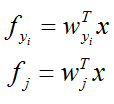
所以,这里要运用链式法则,对梯度求偏导一共有两层:

dscoresdw 比较简单,主要解释 dlossdscores :
j!= yi 针对错误项分母进行求偏导:
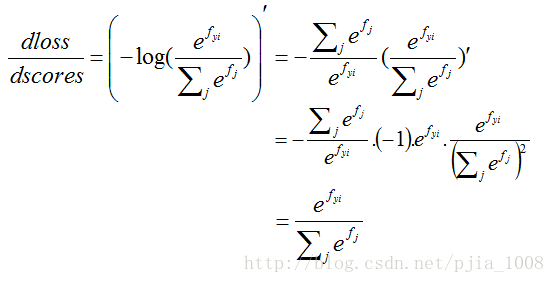
j== yi 针对分子进行求偏导:
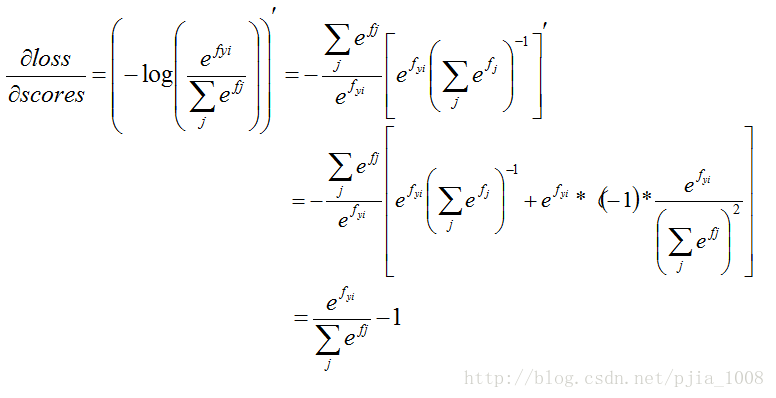
dlossdscores 到这里就完成了,再继续求 dscoresdw=x ,最终再乘上 dlossdscores 就完成了softmax的梯度求导了!
SVM与Softmax分类器的比较
对于学习过二元逻辑回归分类器的读者来说,Softmax分类器就可以理解为逻辑回归分类器面对多个分类的一般化归纳。SVM将输出 f(xi,W) 作为每个分类的评分(因为无定标,所以难以直接解释)。与SVM不同,Softmax的输出(归一化的分类概率)更加直观,并且从概率上可以解释,这一点后文会讨论。在Softmax分类器中,函数映射 f(xi;W)=Wxi 保持不变,但将这些评分值视为每个分类的未归一化的对数概率,并且将折叶损失(hinge loss)替换为交叉熵损失(cross-entropy loss)。公式如下:

在上式中,使用
fj
来表示分类评分向量
f
中的第
下图有助于区分这 Softmax和SVM这两种分类器:
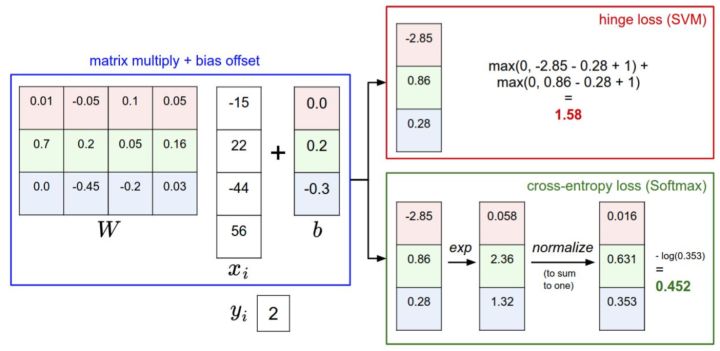
总体代码展示
打开softmax.ipynb:
import random
import numpy as np
from cs231n.data_utils import load_CIFAR10
import matplotlib.pyplot as plt
%matplotlib inline
plt.rcParams['figure.figsize'] = (10.0, 8.0) # set default size of plots
plt.rcParams['image.interpolation'] = 'nearest'
plt.rcParams['image.cmap'] = 'gray'加载数据并预处理
def get_CIFAR10_data(num_training=49000, num_validation=1000, num_test=1000, num_dev=500):
"""
Load the CIFAR-10 dataset from disk and perform preprocessing to prepare
it for the linear classifier. These are the same steps as we used for the
SVM, but condensed to a single function.
"""
# Load the raw CIFAR-10 data
cifar10_dir = 'cs231n/datasets/cifar-10-batches-py'
X_train, y_train, X_test, y_test = load_CIFAR10(cifar10_dir)
# subsample the data
mask = range(num_training, num_training + num_validation)
X_val = X_train[mask]
y_val = y_train[mask]
mask = range(num_training)
X_train = X_train[mask]
y_train = y_train[mask]
mask = range(num_test)
X_test = X_test[mask]
y_test = y_test[mask]
mask = np.random.choice(num_training, num_dev, replace=False)
X_dev = X_train[mask]
y_dev = y_train[mask]
# Preprocessing: reshape the image data into rows
X_train = np.reshape(X_train, (X_train.shape[0], -1))
X_val = np.reshape(X_val, (X_val.shape[0], -1))
X_test = np.reshape(X_test, (X_test.shape[0], -1))
X_dev = np.reshape(X_dev, (X_dev.shape[0], -1))
# Normalize the data: subtract the mean image
mean_image = np.mean(X_train, axis = 0)
X_train -= mean_image
X_val -= mean_image
X_test -= mean_image
X_dev -= mean_image
# add bias dimension and transform into columns
X_train = np.hstack([X_train, np.ones((X_train.shape[0], 1))])
X_val = np.hstack([X_val, np.ones((X_val.shape[0], 1))])
X_test = np.hstack([X_test, np.ones((X_test.shape[0], 1))])
X_dev = np.hstack([X_dev, np.ones((X_dev.shape[0], 1))])
return X_train, y_train, X_val, y_val, X_test, y_test, X_dev, y_dev
# Invoke the above function to get our data.
X_train, y_train, X_val, y_val, X_test, y_test, X_dev, y_dev = get_CIFAR10_data()
print ('Train data shape: ', X_train.shape)
print ('Train labels shape: ', y_train.shape)
print ('Validation data shape: ', X_val.shape)
print ('Validation labels shape: ', y_val.shape)
print ('Test data shape: ', X_test.shape)
print ('Test labels shape: ', y_test.shape)
print ('dev data shape: ', X_dev.shape)
print ('dev labels shape: ', y_dev.shape)OUTPUT:
Train data shape: (49000, 3073)
Train labels shape: (49000,)
Validation data shape: (1000, 3073)
Validation labels shape: (1000,)
Test data shape: (1000, 3073)
Test labels shape: (1000,)
dev data shape: (500, 3073)
dev labels shape: (500,)
Softmax分类器的实现
打开cs231n\classifiers文件夹中的 softmax.py 完成SVM的实现代码。
方法一:
import numpy as np
def softmax_loss_naive(W, X, y, reg):
# Initialize the loss and gradient to zero.
loss = 0.0
dW = np.zeros_like(W)
num_classes = W.shape[1]
num_train = X.shape[0]
for i in range(num_train):
scores = X[i].dot(W)
correct_class = y[i]
exp_scores = np.zeros_like(scores)
row_sum = 0
for j in range(num_classes):
exp_scores[j] = np.exp(scores[j])
row_sum += exp_scores[j]
loss += -np.log(exp_scores[correct_class]/row_sum)
#compute dW loops:
for k in range(num_classes):
if k != correct_class:
dW[:,k] += exp_scores[k] / row_sum * X[i]
else:
dW[:,k] += (exp_scores[correct_class]/row_sum - 1) * X[i]
loss /= num_train
reg_loss = 0.5 * reg * np.sum(W**2)
loss += reg_loss
dW /= num_train
dW += reg * W
return loss, dW方法二 矢量化:
def softmax_loss_vectorized(W, X, y, reg):
# Initialize the loss and gradient to zero.
loss = 0.0
dW = np.zeros_like(W)
num_train = X.shape[0]
scores = X.dot(W)
correct_class_score = scores[np.arange(num_train),y].reshape(num_train,1)
exp_sum = np.sum(np.exp(scores),axis=1).reshape(num_train,1)
loss += np.sum(np.log(exp_sum) - correct_class_score)
loss /= num_train
loss += 0.5 * reg * np.sum(W * W)
#compute gradient
margin = np.exp(scores) / exp_sum
margin[np.arange(num_train),y] += -1
dW = X.T.dot(margin)
dW /= num_train
dW += reg * W
return loss, dW梯度检查
返回softmax.ipynb
# Complete the implementation of softmax_loss_naive and implement a (naive)
# version of the gradient that uses nested loops.
loss, grad = softmax_loss_naive(W, X_dev, y_dev, 0.0)
# As we did for the SVM, use numeric gradient checking as a debugging tool.
# The numeric gradient should be close to the analytic gradient.
from cs231n.gradient_check import grad_check_sparse
f = lambda w: softmax_loss_naive(w, X_dev, y_dev, 0.0)[0]
grad_numerical = grad_check_sparse(f, W, grad, 10)
# similar to SVM case, do another gradient check with regularization
loss, grad = softmax_loss_naive(W, X_dev, y_dev, 1e2)
f = lambda w: softmax_loss_naive(w, X_dev, y_dev, 1e2)[0]
grad_numerical = grad_check_sparse(f, W, grad, 10)其中,梯度检查函数为:
def grad_check_sparse(f, x, analytic_grad, num_checks=10, h=1e-5):
"""
sample a few random elements and only return numerical
in this dimensions.
"""
for i in range(num_checks):
ix = tuple([randrange(m) for m in x.shape])
oldval = x[ix]
x[ix] = oldval + h # increment by h
fxph = f(x) # evaluate f(x + h)
x[ix] = oldval - h # increment by h
fxmh = f(x) # evaluate f(x - h)
x[ix] = oldval # reset
grad_numerical = (fxph - fxmh) / (2 * h)
grad_analytic = analytic_grad[ix]
rel_error = abs(grad_numerical - grad_analytic) / (abs(grad_numerical) + abs(grad_analytic))
print ('numerical: %f analytic: %f, relative error: %e' % (grad_numerical, grad_analytic, rel_error))计算loss和梯度
tic = time.time()
loss_naive, grad_naive = softmax_loss_naive(W, X_dev, y_dev, 0.00001)
toc = time.time()
print ('naive loss: %e computed in %fs' % (loss_naive, toc - tic))
from cs231n.classifiers.softmax import softmax_loss_vectorized
tic = time.time()
loss_vectorized, grad_vectorized = softmax_loss_vectorized(W, X_dev, y_dev, 0.00001)
toc = time.time()
print ('vectorized loss: %e computed in %fs' % (loss_vectorized, toc - tic))
# As we did for the SVM, we use the Frobenius norm to compare the two versions
# of the gradient.
grad_difference = np.linalg.norm(grad_naive - grad_vectorized, ord='fro')
print ('Loss difference: %f' % np.abs(loss_naive - loss_vectorized))
print ('Gradient difference: %f' % grad_difference)OUTPUT: naive loss: 2.371882e+00 computed in 0.189139s
vectorized loss: 2.371882e+00 computed in 0.026646s
Loss difference: 0.000000
Gradient difference: 0.000000
随机梯度下降
与SVM一样,在linear_classifier.py 文件中实现SGD函数
预测准确度
与SVM一样,在linear_classifier.py 文件中实现【predict】函数
利用交叉验证集调整超参数
from cs231n.classifiers import Softmax
results = {}
best_val = -1
best_softmax = None
learning_rates = [1e-7, 5e-7]
regularization_strengths = [5e4, 1e8]
################################################################################
# TODO: #
# Use the validation set to set the learning rate and regularization strength. #
# This should be identical to the validation that you did for the SVM; save #
# the best trained softmax classifer in best_softmax. #
################################################################################
iters = 2000
for lr in learning_rates:
for rs in regularization_strengths:
softmax = Softmax()
softmax.train(X_train, y_train, learning_rate=lr, reg=rs, num_iters=iters)
y_train_pred = softmax.predict(X_train)
acc_train = np.mean(y_train == y_train_pred)
y_val_pred = softmax.predict(X_val)
acc_val = np.mean(y_val == y_val_pred)
results[(lr, rs)] = (acc_train, acc_val)
if best_val < acc_val:
best_val = acc_val
best_softmax = softmax
################################################################################
# END OF YOUR CODE #
################################################################################
# Print out results.
for lr, reg in sorted(results):
train_accuracy, val_accuracy = results[(lr, reg)]
print ('lr %e reg %e train accuracy: %f val accuracy: %f' % (
lr, reg, train_accuracy, val_accuracy))
print ('best validation accuracy achieved during cross-validation: %f' % best_val)OUTPUT:
lr 1.000000e-07 reg 5.000000e+04 train accuracy: 0.326796 val accuracy: 0.343000
lr 1.000000e-07 reg 1.000000e+08 train accuracy: 0.100265 val accuracy: 0.087000
lr 5.000000e-07 reg 5.000000e+04 train accuracy: 0.331020 val accuracy: 0.355000
lr 5.000000e-07 reg 1.000000e+08 train accuracy: 0.100265 val accuracy: 0.087000
best validation accuracy achieved during cross-validation: 0.355000
在测试集上验证
# evaluate on test set
# Evaluate the best softmax on test set
y_test_pred = best_softmax.predict(X_test)
test_accuracy = np.mean(y_test == y_test_pred)
print ('softmax on raw pixels final test set accuracy: %f' % (test_accuracy, ))OUTPUT: softmax on raw pixels final test set accuracy: 0.339000
# Visualize the learned weights for each class
w = best_softmax.W[:-1,:] # strip out the bias
w = w.reshape(32, 32, 3, 10)
w_min, w_max = np.min(w), np.max(w)
classes = ['plane', 'car', 'bird', 'cat', 'deer', 'dog', 'frog', 'horse', 'ship', 'truck']
for i in range(10):
plt.subplot(2, 5, i + 1)
# Rescale the weights to be between 0 and 255
wimg = 255.0 * (w[:, :, :, i].squeeze() - w_min) / (w_max - w_min)
plt.imshow(wimg.astype('uint8'))
plt.axis('off')
plt.title(classes[i])OUTPUT:
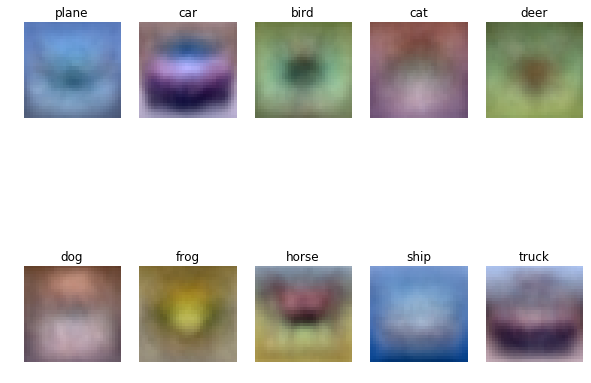






















 1203
1203

 被折叠的 条评论
为什么被折叠?
被折叠的 条评论
为什么被折叠?








